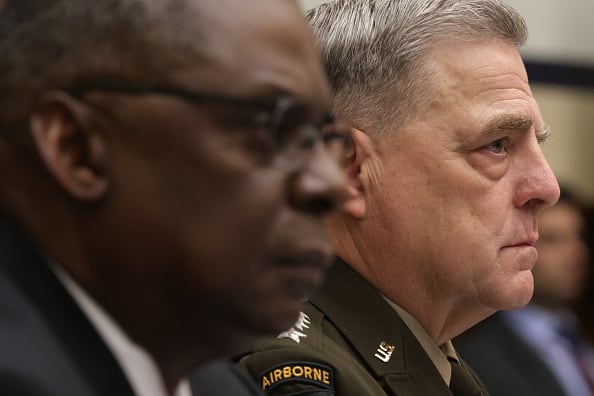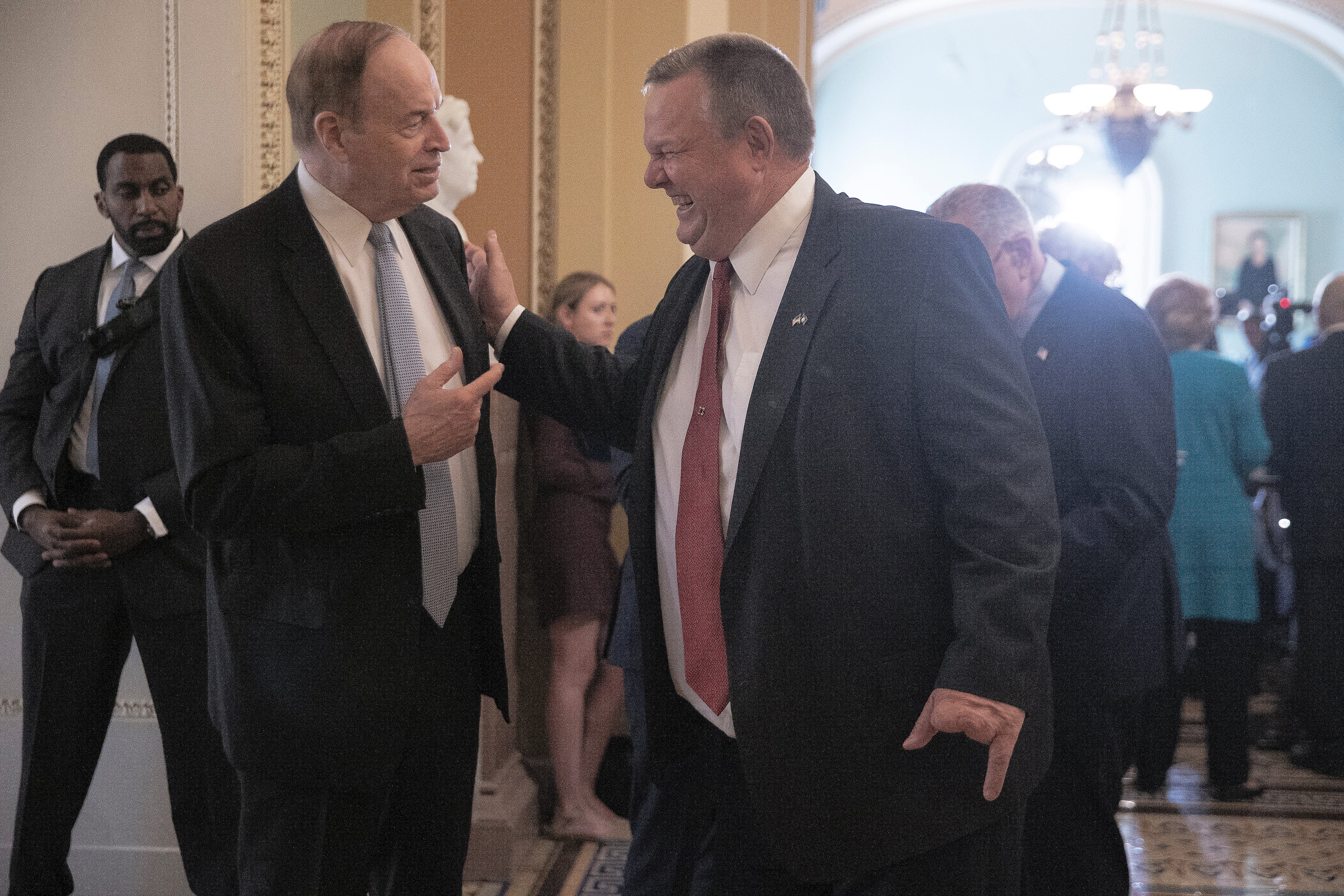WASHINGTON ― Senate Armed Services Committee Chairman Jack Reed says the defense top line “will probably go up” to win Republican support on the path to a budget deal for fiscal 2022 ― and some other key Democrats on defense matters are grudgingly saying the same.
The comments came days after Reed’s panel unveiled plans for a $740 billion defense authorization bill, which includes billions of dollars more in equipment purchases than President Joe Biden’s $716 billion Pentagon request, surprising outside observers. Reed, who is a senior appropriator, predicted that an added $25 billion eventually “will be part of the [Senate] approps bill.”
“People are looking ahead at the final budget resolution, and the Republicans have made it clear that they’re not satisfied with the defense number and they would require more,” said Reed, D-R.I.. “What we’re presenting is what the Pentagon sent over and what they feel is necessary to do their mission.”
On July 14, an FY22 defense appropriations bill that tracks with Biden’s budget advanced out of the House Appropriations Committee, but with weak support. Republicans on the panel, unified in opposition because of the top line, didn’t commit any votes to it ― and Democratic leaders have since held it back from the floor amid dissent from progressives.
On July 22, the evenly divided SASC held a strong bipartisan vote, 23-3, to advance its $740 billion version of the annual National Defense Authorization Act. The panel had voted 25-1 to adopt the $25 billion increase as an amendment from the panel’s top Republican, Sen. Jim Inhofe of Oklahoma.
Republican lawmakers in the House and Senate have lobbied against Biden’s figure for weeks, saying it would be insufficient to counter threats like a growing Chinese military and terrorist groups worldwide. In the narrowly divided House and the 50-50 Senate, Democrats will likely need Republicans to pass defense measures.
Asked last week, House Armed Services Committee Chairman Adam Smith, D-Wash., acknowledged it’s likely that his panel’s version of the National Defense Authorization Act will end up exceeding Biden’s top line. A progressive but also a pragmatist, Smith told Defense News he doesn’t agree with the increase but is open to the idea as a means of advancing the bill.
“The people who want to spend more than the Biden number have built a lot of support, and yes, I think that [$25 billion increase] is a potential bipartisan pathway,” Smith said. “I don’t support it, I don’t think that’s where we should go, but at the end of the day, I have one vote.”
“The reality is, as we’ve seen with the defense appropriations bill, we do not have the votes to pass it with just Democrats, and that’s the worst kept secret in the building,” he added. “And it is very important to pass a defense bill; it has a lot of important policies that we’re trying to get done.”
Along similar lines, the Senate Democrat in charge of funding the Pentagon, Sen. Jon Tester, said the way to avoid a budgetary impasse with Republicans ― and a stopgap continuing resolution at the Oct. 1 fiscal deadline ― is to agree to a plus-up. Like Reed, he foresees the Senate Appropriations Committee eventually mirroring SASC.
“Hopefully what that’s going to do is allow us to get a defense bill through the process ― and by the way, there’s plenty of reasons, plenty of threats ― but get it through the process so we don’t end up with a CR,” said Tester, a centrist from Montana.
Tester would like to begin work on the defense spending bill soon and have it over the finish line by mid-September, but the process is stuck. Senate Appropriations Chairman Patrick Leahy, D-Vt., has for months been calling for bipartisan, bicameral talks with the White House to establish top lines before his panel starts its work.
RELATED

Last week, Senate Appropriations Committee Vice Chairman Richard Shelby, R-Ala., called the SASC NDAA “a positive step,” but he stopped short of abandoning his months-old demand that any increases to nondefense discretionary spending be matched on the defense side. Compared with this fiscal year, Biden’s proposal would hike the nondefense budget up 16 percent and nudge the defense budget up 1.6 percent.
“I thought that was a good sign for some of us who believe national security is very, very important,” Shelby said of the SASC NDAA. “Sometimes, and we all know it’s not what you want, it’s what you can get ― and that is a positive step. Would we like more? We would, but so does every agency.”
Meanwhile, some key Democrats want to stick to Biden’s top line. Tester’s counterpart in the House, who shepherded a bill that matched Biden’s number, told Congressional Quarterly last week that she was not a fan of the heftier, SASC-approved defense budget.
“The Senate can do what it chooses to do. So far I haven’t seen much action or anything ever come out of the Senate,” said Rep. Betty McCollum, D-Minn. “I support the number that I marked up to.”
But even at the lower figure, the support of the House’s progressive bloc cannot be won. Progressives remain concerned over nuclear spending, the Pentagon’s lack of a complete audit and most of all the ever-increasing top line, according to Congressional Progressive Caucus Chair Pramila Jayapal.
“Chairwoman McCollum has done an amazing job. She has crafted a much better bill than ever before, but as you know, the critical issue for progressives has been the top-line number,” Jayapal, D-Calif., told Defense News. “It does not help that the Senate Democrats added $25 billion to the [administration’s] number. Because we feel like it’s, no matter what the number is, it has to go up.”
Progressive Democrats may get the most headlines, but there’s another influential group who tends to agree with Republicans on the top line: The so-called national security Democrats, made up of former military or intelligence officers, most of whom have flipped red districts blue and should be facing tough re-election fights in 2022.
One of them, House Armed Services Committee Vice Chair Elaine Luria has been outspoken that Biden’s proposed defense budget “does not meet the level” the military needs to keep pace with China. Luria, whose Virginia district includes the world’s largest naval base, is a 20-year naval veteran and nuclear-trained surface warfare officer.
“We should match what the Senate has done, and I would clearly like to see 3-5 percent real growth,” she said of the top line during the HASC Readiness Subcommittee markup last Thursday.
On the Senate side, Sen. Tammy Duckworth, who’s running again in 2022 after reclaiming an Illinois Senate seat for Democrats in 2016, had a similar message. A combat-wounded Army helicopter pilot, Duckworth chairs the Senate Airland Subcommittee.
“I think it’ll make it through,” Duckworth said of the $25 billion boost, noting that Congress routinely added to the defense top line while Donald Trump was president.
“Why are people surprised when this is what we have always done?” she said. “And frankly, with the tempo that our military has been going through, they need this extra money so that they can maintain their readiness.”
Amid the Democratic fractures, House Republicans are “totally united” against Biden’s defense top line, according to Rep. Ken Calvert, the top Republican on the House Appropriations Committee’s defense subpanel. To him, it’s inevitable that a final budget deal matches SASC’s hike to $740 billion.
“At the end of the process, that number will be the number for defense appropriations,” Calvert told reporters at the Capitol last week.
Smith, who long predicted an internal fight over the top line, argued a better course for Democrats than rejecting national security measures wholesale, as some progressives do. He said Democrats should take part in drafting them to make sure they hew to Democratic values.
“I can say: ‘Look, you’re right, there’s some things we got to improve.’ But if it’s just a bright line in the sand, you’re just not voting, ‘we just don’t want to have any responsibility for that?’ That’s not a good message coming from the Democratic Party,” Smith said.
If a top-line boost is unavoidable, it looks like the next fight will be about how to spend it.
Smith was skeptical of SASC’s plus-up for the F-35 Joint Strike Fighter, among other longstanding programs ― and that’s on brand for him. With an eye on Russia and China, Smith has for months been calling for forward-leaning investments in information warfare, survivable platforms, command-and-control systems, cyberwarfare, and satellite technologies.
“I’m not going to choose just killing the defense bill over being forced into a negotiation about how much money to spend, right? Let me say, where we spend that money matters,” Smith said. “I wasn’t overwhelmingly impressed by what I’ve read about where the Senate chose to spend the money. Just buying more platforms because you’ve got the money? How does that fit into the National Security Strategy?”
Leo Shane III in Washington, D.C., contributed to this report.
Joe Gould was the senior Pentagon reporter for Defense News, covering the intersection of national security policy, politics and the defense industry. He had previously served as Congress reporter.
